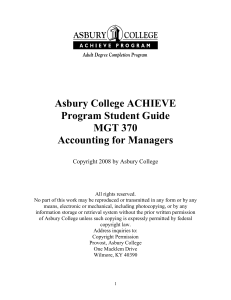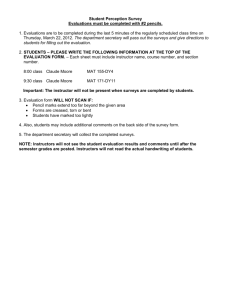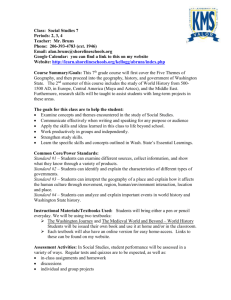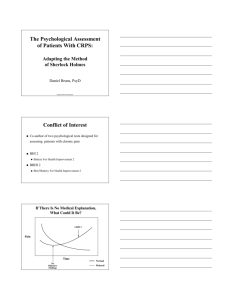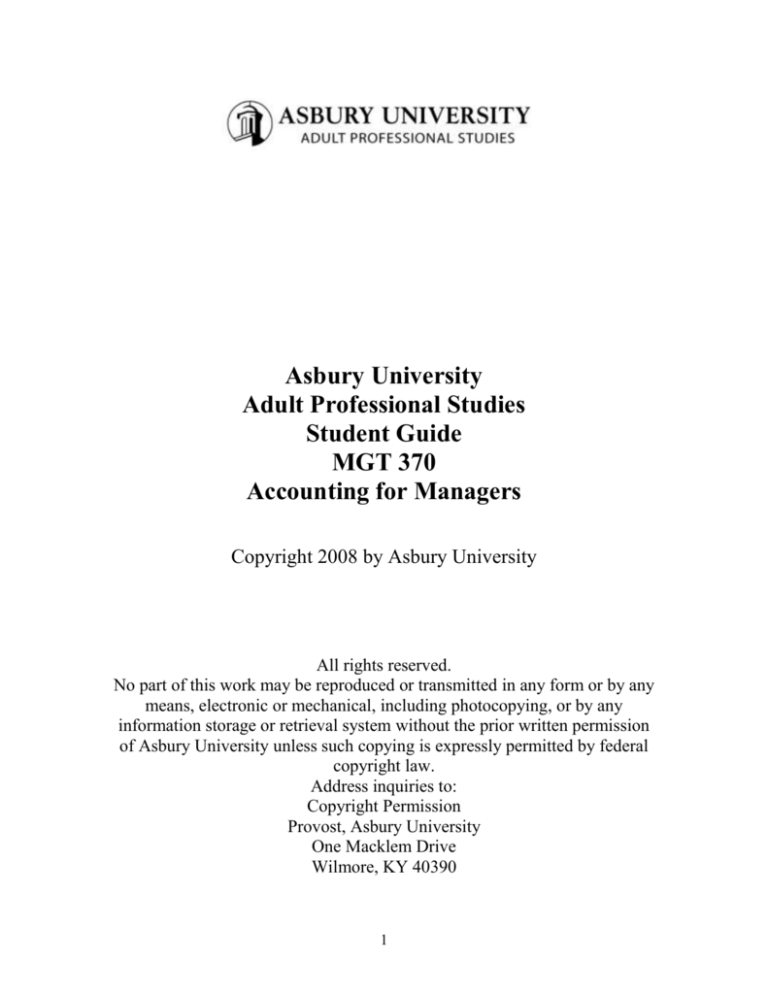
Asbury University
Adult Professional Studies
Student Guide
MGT 370
Accounting for Managers
Copyright 2008 by Asbury University
All rights reserved.
No part of this work may be reproduced or transmitted in any form or by any
means, electronic or mechanical, including photocopying, or by any
information storage or retrieval system without the prior written permission
of Asbury University unless such copying is expressly permitted by federal
copyright law.
Address inquiries to:
Copyright Permission
Provost, Asbury University
One Macklem Drive
Wilmore, KY 40390
1
Asbury University Mission Statement
Statement of Mission: The mission of Asbury University, as a Christian Liberal
Arts University in the Wesleyan-Holiness tradition, is to equip men and women,
through a commitment to academic excellence and spiritual vitality, for a lifetime
of learning, leadership and service to the professions, society, the family and the
Church, thereby preparing them to engage their cultures and advance the cause of
Christ around the world.
Asbury University is intentional about outcomes. The University seeks to produce
students who are academically equipped to meet the real challenges of faithful,
responsible and contributive living in their world. Asbury University is committed
to producing women and men who will realize their full potentials for leadership
and service, who are confident in who they are, and who will negotiate their life‘s
journey with insight, courage, and joy. The total learning experience is intended to
produce students who appreciate the life of the mind and are capable of thinking
critically. The University seeks to produce students who can read, speak and write
effectively and who will be lifelong learners—‗empowered, informed and
responsible.‘
The University endeavors to promote the development of a clear sense of
commitment to Christ, to nurture a reasoned, resilient, and formidable faith, and to
give students the tools of understanding they require to respond fully to God‘s call
upon their lives. Students are encouraged to examine their faith, to cultivate a
personally owned faith, to enter into an experience of scriptural holiness, and to
develop a capacity for responding to life‘s realities with intelligence, creativity,
moral responsibility, and compassion – students with servant hearts and a concern
for others.
Asbury University Adult Professional Studies Mission
Statement
The mission of the ADULT PROFESSIONAL STUDIES Program is to provide a
quality academic program, within a Christian context, that equips nontraditional
students to achieve professional excellence in their chosen field. The ADULT
PROFESSIONAL STUDIES Program prepares students for leadership and service
to others, cultivates attitudes of lifelong learning, and fosters spiritual
development.
2
MGT 370
Accounting for Managers
Letter to the Student from the Instructor
Many, if not all of you have been dreading this accounting course. Rest easy… you will
survive! This course is designed to help you gain an understanding of what accountants
do and why they do it. It is not intended to teach you how to be an accountant, but more
so to teach you the terminology to better communicate with accountants and to provide
you with tools to analyze and utilize the economic data produced through the accounting
process. It is designed on the premise that you have had no or minimal exposure to
accounting.
Each week you will have case studies and writing assignments to challenge you to apply
the concepts presented to you in the reading and class discussion. The concepts that you
learn are applicable to both your personal and professional life. As you go through your
assignments, I would challenge you to go beyond the required reading and demonstrate
your understanding of these concepts in your responses.
Do not be intimidated by this course and the concepts that will be reviewed. If you are
struggling with an assignment or concept, utilize online tools, the PowerPoint slides, your
classmates and your instructor as resources. The business world is a collaborative and
resourceful environment and this class should be no different. You are encouraged to
make use of the resources that you would have available to you in ―the real world.‖
Don‘t be afraid to use them!
I‘m sure that you are all excited that there is no final exam for this course. The final
project will act as a capstone for your learning experience, but don‘t wait to start working
on it. The interim due dates are designed to help you stay on schedule and obtain
feedback from your instructor on your progress.
I hope that by the end of this course you can appreciate what accountants do and how you
can use the information that they provide to benefit you both personally and
professionally.
Emily Walsh, MBA
3
Syllabus
Course Name: Accounting for Managers
Course Number: MGT 370
Text and Required Materials:
Bruns Jr., William J. Accounting for Managers: Text and Cases. Third Edition. Mason,
OH: Thomson South-Western, 2005. ISBN: 0-324-29121-3.
Student Resources:
Student’s CD-ROM – This CD includes PowerPoint slides of the text reading
assignments and Excel spreadsheet templates for the assigned case studies.
principlesofaccounting.com – This website provides a complete text online. Chapter 1
and a portion of Chapters 16 & 17 will be used for assigned reading. This text can also
be used as a more in-depth resource for other topics during this course.
The online text is divided into three sections: Financial Accounting,
Understanding/Using Accounting Information, and Managerial Accounting. Financial
Accounting and Understanding/Using Accounting Information will be covered in a
condensed version during weeks 1 and 2. Managerial Accounting will be reviewed
during weeks 3 and 4.
Asbury University received permission from Dr. Larry Walther, author of
principlesofaccounting.com, on October 26, 2007 to use information from the text in the
Power Point slides provided to students.
If there are any issues accessing this website or any other website referenced in the
Student Guide, please contact the instructor.
Course Description:
A study of what accountants do and why they do it, designed to help managers utilize the
reports and information available as effectively as possible.
Course Objectives:
The students will:
1. Have an understanding of the role of accounting and the impact that this has on nonfinancial managers. Chapters 1 & 17 (principlesofaccounting.com)
2. Be familiar with the accounting framework and how it is used in evaluating economic
conditions and success and in decision making in organizations. Chapter 1
(principlesofaccounting.com), Part 1 (Bruns)
3. Have a sense for the conceptual basis of accounting as it is carried out in
organizations today. Part 2 (Bruns)
4
4. Be familiar with financial statements, accounting reports, and the vocabulary found
within them. Chapter 1 (principlesofaccounting.com), Part 1, 2 & 3 (Bruns)
5. Have a sense of how managers use a reporting strategy in communicating with each
other and with parties external to their organization. Part 3 (Bruns)
6. Understand the complexity of determining and using information on the cost of
products and services produced by the organization. Part 4, 5 & 6 (Bruns)
7. Understand the power of measurements in coordinating, motivating, and evaluating
the activities of employees and managers in modern organizations. Part 7 (Bruns)
5
Student Evaluation
Students will be evaluated under the University‘s standard grading system. Refer to the
Student Handbook or the University Catalog for additional details. The criteria for grading
will be as follows:
1. (15%) Completion of case studies assigned as ―complete questions‖ (see Required
Assignments for assignments per week). Week 1 assignment will count as a case study.
2. (15%) Completion of writing assignments (see Required Assignments for assignments
per week).
3. (20%) Attendance and participation in class discussion and group activities. The criteria
will be the quality and contribution to the class.
4. (50%) Financial Analysis Project
Case Studies: The assigned case studies will be used as part of the classroom discussion for
this course. Case studies assigned as ―complete questions‖ must be submitted prior to class
in Discovery. Questions for the case studies are either included at the end of the case or in
your Required Assignments. There are additional case studies included in the text;
reviewing the unassigned case studies is optional reading.
Writing Assignments: The writing assignments should be typewritten in a professional
business format (i.e. headings/sub-headings). There is no page requirement for these
assignments; however, ensure that all questions for the assignment are answered. Students
are encouraged to apply class material and real-world examples in answering the questions.
Cite Resources: Use of material written by another person without giving credit to that
person is plagiarism and will result in an ―F‖ for the assignment. When using somebody
else‘s work with either a direct quote or paraphrase, cite the resource within your paper.
Instructions for citing a resource and preparing a works cited page are available on the Web.
Attendance: Students are required to attend all class sessions. If a student misses a class
due to extenuating circumstances, the student must seek to arrange an alternative assignment
with the instructor that will take a minimum of four hours to complete for the class
participation grade for that missed class session. If no assignment is given or completed, the
portion of the grade for class participation will be deducted.
A student is considered tardy if arriving more than one half hour late for class or if leaving
more than one half hour before the end of class. Such tardy or early class departure is
considered a one-third absence. Three times of such tardiness/early departure will equal one
class absence.
More than one class absence in a course requires a failing (F) grade regardless of
circumstances. To formally withdraw from a course, the student must meet the conditions
for withdrawal established through the Registrar‘s Office. There are no exceptions to the
absence policy. The ADULT PROFESSIONAL STUDIES Program Director is not
6
authorized to make exceptions.
Late Work or Work Not Handed In: Any case study, written assignment or Final Project
handed in after 6 p.m. on the due date will result in a reduction of the grade for that item.
Any item not turned in will result in an ―F‖ for that item and a reduction of the grade for the
course.
Final Exam: There is no final exam for this course. Part 3 of the Financial Analysis Project
will be the final assignment for this course. Work on the project should begin immediately
by selecting a public company for the project.
7
Required Assignments
Financial Analysis Project
Every student must complete a Financial Analysis Project. Students are allowed to use any
material or talk to any person to develop this project. Any references to the work of another
person must be cited within your project.
The Financial Analysis Project is adopted from a case in the Brun Text. Details of the
project are included in the Financial Analysis Project document included in the files for this
course.
Each student will review a publicly traded company approved by the instructor. No two
students can analyze the same company. As a result, the student’s top two choices should
be provided to the instructor at the first class. Companies will be formally assigned by the
end of the first class.
The project is divided into three phases to ensure that the student is on track and to allow the
instructor an opportunity to provide feedback for the next phase. Part 1 is due at the second
class and will be returned to the student at the Week 3 class. Part 2 is due at the fourth class
and will be returned at the Week 5 class. Part 3 is due one week after the final class session.
Each report should include a cover page with the student‘s name, course name and number,
instructor‘s name and the due date. The structure of each report should follow the outline
presented in the project document. For example, Part 1 should include sub-headings for
―Company Background,‖ ―Developments relating to the Company,‖ etc. Students are
encouraged to use external resources to support ideas and findings.
Chapter 16 in the principlesofaccounting.com text is a good resource to use when
completing the financial ratio analysis for Part 3.
Week One
1. Reading Assignment:
A. Letter to Students (in the Student Guide)
B. principlesofaccounting.com*:
Chapter 1
Chapter 17 (―Managerial Accounting‖ and ―Planning, Directing and
Controlling‖ sections only)
C. Bruns Text:
Introduction (page xii)
The Accounting Framework, Financial Statements, and Some
8
Accounting Concepts (page 1-2)
Maria Hernandez & Associates (page 1-16)
Introduction to Accounting Records (page 1-19)
Introduction to Financial Ratios and Financial Statement Analysis (page
1-50)
Financial Analysis Project (file included with this course)
2. Case Studies:
A. Maria Hernandez & Associates – Read prior to class to prepare for in-class
exercise
B. Personal Financial Statements – You are required to prepare your own personal
balance sheet and statement of cash flow. Additional information regarding the
assignment is provided in Discovery under Week 1. Additional reading that will
aid in the process is also available in Discovery.
3. Writing Assignment**: Describe your perceptions of what accounting is and what
accountants do. What are your expectations for this course?
4. Financial Analysis Project: Review the project file in the course documentation. Select
your top two choices of publicly traded companies that you want to use for your final
project.
*If there are any issues accessing the websites referenced in the Student Assignments, please
contact the instructor.
**Writing Assignment 1 will be treated as part of the Participation grade for week one.
There are no formatting requirements for this paper other than that it be submitted in
Microsoft Word.
Week Two
1. Reading Assignment:
A. Bruns Text:
Accounting for Current Assets (page 2-2)
The Question of LIFO or FIFO; Which Is Preferable (page 2-13)
Recognizing Revenues and Expenses: When Is Income Earned? (page
2-17)
Circuit City Stores, Inc. (page 2-21)
Accounting for Property, Plant, and Equipment and Other Assets (page
2-33)
Liabilities and Time (page 2-73)
Introduction to Owners‘ Equity (page 2-99)
Solving the Puzzle of the Cash Flow Statement (page 2-107)
Crystal Meadows of Tahoe, Inc. (page 2-121)
9
2. Case Studies:
A. The Question of LIFO or FIFO; Which Is Preferable – Be prepared to discuss in
class (completed template available for review)
B. Circuit City Stores, Inc. – Be prepared to discuss in class
C. Crystal Meadows of Tahoe, Inc. – Complete questions on page 2-122 (use Excel
template)
3. Writing Assignment: There is no writing assignment due.
4. Financial Analysis Project: Part 1 is due. Be prepared to discuss the results of your report
in class.
Week Three
1. Reading Assignment:
A. Bruns Text:
Auditors and Their Opinions (page 3-2)
Accounting‘s Global Rule Book; When it Comes to the Numbers, Why
Can‘t the World Agree? (page 3-9)
Diversity in Accounting Principles: A Problem, a Strategic Imperative,
or a Strategic Opportunity? (page 3-31)
Harnischfeger Corporation (page 3-61)
Understanding Costs for Management Decisions (page 4-2)
Prestige Telephone Company (page 4-13)
Buying Time (page 2-67)
B. ―No More Mr. Nice Guy‖ (on the cfo.com website)
C. ―A Tough Act to Follow‖ (on the cfo.com website)
2. Case Studies:
A. Harnischfeger Corporation – Be prepared to discuss in class (completed template
available for review)
i. Identify the accounting policy changes and accounting estimates made
during 1984. Estimate the effect of these changes on the company‘s
reported profits.
ii. What do you think are the motives of Harnischfeger‘s management in
making the changes in its financial reporting policies? Do you think
investors will ―see through‖ these changes?
iii. Assess the company‘s future prospects given your insight from questions
1 and 2 and the information in the case on the company‘s turnaround
strategy.
B. Prestige Telephone Company – Complete questions on page 4-15 (use Excel
template)
10
C. Buying Time – Be prepared to discuss questions for Practice Example #2 on page
2-72 in class (completed template available for review)
3. Writing Assignment: Read “No More Mr. Nice Guy” and “A Tough Act to Follow” on
the cfo.com website. With these articles and other current research that you find,
develop a written response using the following points of discussion:
A. What place do ethics have in the world of accounting?
B. What is Sarbanes-Oxley? Why was it established? How has it impacted today‘s
business world?
C. Identify a biblical example (either positive or negative) that connects with the
concept of ethics in accounting.
D. Identify a ―real-world‖ example or personal experience that correlates with the
topic of ethical conduct as it relates to finances or financial information.
4. Financial Analysis Project: Part 1 will be returned to students.
Week Four
1. Reading Assignment:
A. Bruns Text:
A Brief Introduction to Cost Accounting (page 4-18)
Hilton Manufacturing Company (page 4-25)
Accounting for Indirect Costs (page 5-2)
Activity Accounting – Another Way to Measure Costs (page 5-16)
Destin Brass Products Co. (page 5-19)
Standard Costs and Variance Analysis (page 5-67)
Mile High Cycles (page 5-80)
2. Case Studies:
A. Hilton Manufacturing Company – Be prepared to discuss in class (completed
template available for review)
B. Destin Brass Products Co. – Be prepared to discuss questions 1 – 3 in class
(completed template available for review)
C. Mile High Cycles – Complete questions on page 5-81 (use Excel template)
3. Writing Assignment: There is no writing assignment due.
4. Financial Analysis Project: Part 2 is due. Be prepared to discuss the results section of
your report in class.
Week Five
1. Reading Assignment:
E. principlesofaccounting.com:
11
Chapter 16 (―Financial Statement Analysis‖ section only)
F. Bruns Text:
Basic Capital Investment Analysis (page 6-2)
Control in an Age of Empowerment (page 7-2)
Nordstrom: Dissension in the Ranks? (page 7-31)
Responsibility Centers and Performance Measurement (page 7-55)
The Balanced Scorecard – Measures that Drive Performance (page 771)
G. Research the terms Capital Budgeting and the Time Value of Money.
2. Case Studies:
A. Chapter 16, problem P-1 (principliesofaccounting.com) – Be prepared to discuss
in class (completed template available for review)
B. Nordstrom: Dissention in the Ranks – Complete questions below
i. What is the cause of the problems described in the case? How serious are
these problems?
ii. Are Nordstrom employees pressured inappropriately by the sales-per-hour
system? By management?
iii. How effective is the memo reproduced as Exhibit 3 in clarifying the
distinction between ―sell‖ and ―non-sell‖ time?
iv. How would you change management systems in Nordstrom?
3. Writing Assignment: In response to the research that you have completed on the terms
Capital Budgeting and the Time Value of Money, develop a written response to the
following questions:
A. Describe your understanding of these terms (including the evaluation methods
that are used in the process of capital budgeting).
B. How does an understanding of these concepts aid you both personally and
professionally?
4. Financial Analysis Project: Part 2 will be returned to students.
12
Weekly Schedule
Course Name: Accounting for Managers
Course Number: MGT 370
Week One
Hour
One
Two
Three
Four
Week Two
Hour
One
Two
Three
Four
Week Three
Hour
One
Two
Three
Four
Topic or Activity
Course Introduction
The World of Accounting
Numbers Exercise
Accounting Framework, Financial Statements & Accounting Concepts
Break
Personal Financial Statements Discussion
Maria Hernandez Case Study
Intro to Accounting Records
Project Discussion
Topic/Activity
Devotional
M&M Game
Accounting for Current Assets
Break
Recognizing Revenues and Expenses
Accounting for PP&E, Liabilities and Owner‘s Equity
Solving the Puzzle of the Cash Flow Statement
(continued)
Progress Report I
Topic/Activity
Devotional
Auditors and Their Opinions & Accounting‘s Global Rule Book
Ethics in Accounting
(continued)
Diversity in Accounting Principles
Break
Understanding Costs for Management Decisions
(continued)
Review for Progress Report II
13
Week Four
Hour
One
Two
Three
Four
Week Five
Hour
One
Two
Three
Four
Topic/Activity
Devotional
Introduction to Cost Accounting
Activity Accounting
Break
Standard Costs and Variance Analysis
(continued)
Progress Report II
Topic/Activity
Devotional
Financial Ratios
(continued)
Break
Control in an Age of Empowerment
(continued)
Basic Capital Investment Analysis
Capital Budgeting
(continued)
Course Summary
Course Evaluation
14

